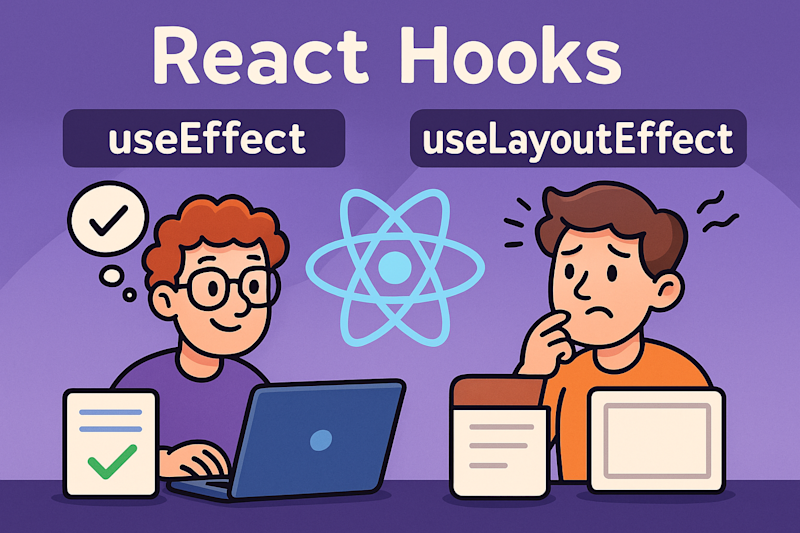
Understanding useEffect vs. useLayoutEffect in React: A Comprehensive Guide
React Hooks have profoundly changed the way we write React applications, allowing developers to manage state and side effects elegantly in functional components. Among these Hooks, useEffect and useLayoutEffect are crucial for handling side effects, but understanding their differences can be tricky yet essential for performance and user experience.
This post deeply explores their differences, execution timing, how they affect rendering and user experience, performance implications, and edge cases.
Execution Timing and Rendering Behavior
useEffect
- Execution: Runs asynchronously after the browser has painted the DOM.
- Impact: Non-blocking; it ensures the UI updates immediately without waiting for the side effect to complete, resulting in a smoother user experience.
useLayoutEffect
- Execution: Executes synchronously immediately after all DOM mutations but before the browser repaints the screen.
- Impact: Blocking; it delays visual updates until its side effects have completed, potentially impacting user experience if misused.
Choosing Between useEffect and useLayoutEffect
When to Use useEffect
- Fetching data or other asynchronous operations.
- Managing side effects that do not require immediate DOM access.
- Most scenarios where performance and non-blocking behavior are beneficial.
When to Use useLayoutEffect
- Measuring DOM elements for size, position, or layout before paint.
- Directly manipulating DOM elements to avoid flickering.
- Critical UI scenarios where immediate consistency is essential.
Practical Examples
Using useEffect for Data Fetching
import React, { useEffect, useState } from 'react';
function FetchDataComponent() {
const [users, setUsers] = useState([]);
useEffect(() => {
async function fetchData() {
const response = await fetch('https://api.example.com/users');
const data = await response.json();
setUsers(data);
}
fetchData();
}, []);
return (
<div>
{users.length === 0 ? <p>Loading...</p> : users.map(user => <p key={user.id}>{user.name}</p>)}
</div>
);
}Using useLayoutEffect for DOM Measurement
import React, { useLayoutEffect, useState, useRef } from 'react';
function MeasureComponent() {
const ref = useRef(null);
const [width, setWidth] = useState(0);
useLayoutEffect(() => {
setWidth(ref.current.offsetWidth);
}, []);
return (
<div ref={ref}>
<p>The width of this element is: {width}px</p>
</div>
);
}Performance Considerations
useLayoutEffect has a synchronous nature that blocks the browser's paint phase. Misuse can lead to sluggishness, particularly if the operations within it are expensive or computationally heavy. It's generally advised to default to useEffect unless the side effect must be resolved before the browser paints.
-
Optimal Use:
- Limit synchronous DOM interactions to scenarios that explicitly require immediate rendering adjustments.
- Keep DOM manipulations within
useLayoutEffectas minimal as possible.
-
Potential Pitfalls:
- Excessive synchronous DOM operations leading to frame drops and reduced user experience.
Edge Cases
Flickering or Layout Shift
When updating DOM elements based on calculations or measurements, using useEffect instead of useLayoutEffect can cause noticeable flicker or layout shifts. In these scenarios, it's essential to switch to useLayoutEffect.
// Potential flickering with useEffect
useEffect(() => {
ref.current.style.height = `${calculateHeight()}px`;
}, []);
// Smooth rendering with useLayoutEffect
useLayoutEffect(() => {
ref.current.style.height = `${calculateHeight()}px`;
}, []);SSR and Warning Issues
Server-Side Rendering (SSR) environments, such as Next.js, may produce warnings when using useLayoutEffect because there is no DOM during server rendering. The common solution is to conditionally use the hook based on the environment:
const useIsomorphicLayoutEffect = typeof window !== 'undefined' ? useLayoutEffect : useEffect;Best Practices
- Always Default to
useEffect: Unless your side effect specifically requires immediate DOM manipulation before paint. - Minimize DOM Access: Reduce expensive DOM interactions in synchronous hooks.
- Proper Dependency Arrays: Clearly define dependencies to avoid unnecessary re-renders or effect executions.
- Testing and Profiling: Use React DevTools Profiler to identify performance bottlenecks.
Conclusion
Understanding the nuanced differences between useEffect and useLayoutEffect enables React developers to optimize rendering performance and improve the user experience. Always default to asynchronous side effects with useEffect, and carefully reserve synchronous useLayoutEffect for necessary DOM measurements or immediate updates to maintain UI consistency without sacrificing performance.
By following these guidelines, you'll avoid subtle bugs and provide smoother interactions, ensuring a more polished and professional React application.